Iran Dress Code
What to wear in Iran for women & men: Comprehensive guide
The dress code of every country is a cultural difference that may seem a bit intimidating or strange at first but should be followed if you want to feel more comfortable and blend into the crowd. Being an Islamic country, Iran has a specific dress code that must be followed by the travelers as well as locals.
Due to all the rumors spread throughout the media Iranian dress code has become one of the travelers’ main concerns. However; the Islamic rules about clothing are not as strict as they may initially seem. Against the common belief women in Iran appreciate colorful clothes and have a great sense of fashion, choosing stylish clothes while following the dress code.
Here we’re about to provide you with a complete guide on how exactly the Iranian dress code is and how flexible it can be.
After the Iranian Revolution in 1979 Islamic rules were legislated, requiring women to wear “Hijab”. In Islam, Hijab refers to modest dressing, specifically covering the head.
At the beginning, most of women were used to wear “Chador”, a long piece of black cloth covering their whole body from head to ankles.
Later on most of women wore “Manteau” (a long coat) instead of Chador and covered their hair with shawl (head scarf). As time went by Manteaus became shorter and people started wearing vibrant colors. Today Iranian women wear short Manteaus or Manteaus without buttons over a shirt and jeans or long skirts and cover their head with colorful Shawls.
Hijab refers to modest dressing in Islamic vocabulary. Nowadays, it mostly refers to covering the head. All Iranian women and tourists are obliged to cover their hair or wear hijab in public areas. Many Iranian women choose to only cover up the top of their head and let a little hair out from the back and front of the head scarf. The most common way is to use a head scarf that you can easily find in local shops, but it’s also possible to use hats especially during winter. Hijab may also refer to covering the body and dressing according to the Iranian dress code as explained in this article.
Like any other country in the world, most of the general laws in Iran have to be followed by travelers. As an Islamic country, there are laws regarding women’s clothing in Iran that must be followed by travelers as well. All women regardless of their nationality are obliged to follow these rules requiring them to wear hijab; however, the rules are not as strict for travelers and their unfamiliarity with Hijab is taken into account. Note that women are required to wear Hijab as soon as they get off the plane in an Iranian airport.
Men and women are only required to follow the dress code in Iran in public areas. Therefore, travelers and locals can freely choose their clothing when they’re inside someone’s house or in a hotel room. However; if you’re invited to a local’s house you may respect their beliefs and avoid wearing revealing clothes. You can also take off your Hijab in women-only areas such as beauty salons and gyms. Note that inside cars, hotel lobbies and restaurants are considered public areas.
Men’s dress code in Iran |
Dos |
Don’ts |
Men’s hairstyle and hats |
|
There is no limitation on men hairstyle or hat type. |
Upper-body clothes and sleeve length |
|

Don’t wear sleeveless shirts. |
Lower-body clothes |
|
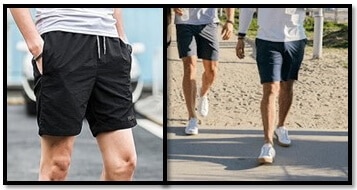
Don’t wear shorts. |
Overall looks |
|
 |
Clothes for adventure tours |
|
|
Proper clothes for visiting religious monuments |
|

Don’t wear sleeveless shirts or shorts. |
Women’s dress code in Iran |
Dos |
Don’ts |
Hairstyle and headcover |
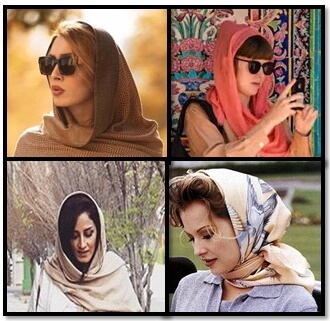
Wearing a headscarf is mandatory, however, covering all of your hair is not important. |
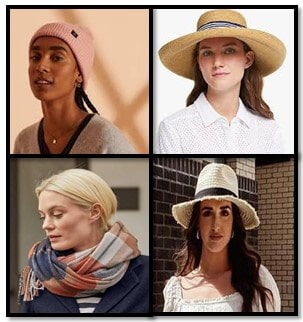
Using a hat/cap is not an alternative to a headscarf. Most of your neck/hair must be covered. |
Upper-body clothes and sleeve length |
|

Don’t wear sleeveless or short-sleeved shirts/coats/tunics. |
Lower-body clothes |
|
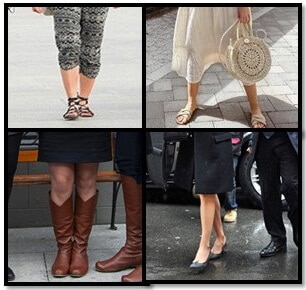
Don’t wear skirts or see-through leggings or see-through pants. Your legs should be covered. |
Overall looks |
|
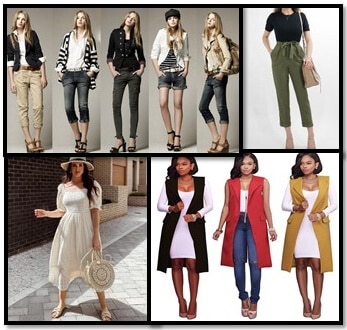 |
Clothes for adventure tours |
|
 |
Proper clothes for visiting religious monuments |
|
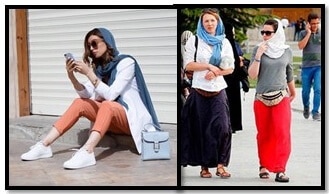
You need to be wearing a Chador in religious monuments. |
It’s obligatory for women to wear hijab in public areas such as the hotel lobby, restaurants and historical monuments.
They should wear a loose sweater, tunic or Manteau, long enough to cover the lower waist. The sleeves must reach the elbows and the legs must be covered until right above the ankles. Wearing jeans, leggings, ripped jeans and loose skirts and dresses is allowed.
Women also have to cover their hair using a headscarf or shawl, which can be purchased at any market or shopping center in Iran. It’s acceptable to show the front part of your head and wear the Shawl halfway as many Iranian women do. It’s also not obligatory to cover the neck and you can wear your Shawl loosely.
There are no restrictions regarding footwear in Iran and women can wear sandals, boots, etc.
All colors are allowed but see-through clothes must be avoided.
Similar to women all around the world, Iranian women enjoy wearing colorful nail polish. Wearing nail polish of all kinds and colors is normal and acceptable in Iran. In fact long nails nail extensions and polished nails are quit common between Iranian women so feel free to use nail polish during your trip to Iran.
The Iranian dress codes requires women to have their legs covered down until the ankles and wear loose tunics or coats that cover their lower waist and have long sleeves. Against the common myth, skinny pants and leggings are very common in Iran. Long dresses and skirts are also often worn by women during the summer and are accepted; however, they mustn’t be see-through. As for men, pants must be long and sleeveless shirts are forbidden; however,t -shirts are accepted. Note that these rules only apply for public areas.
Iranians appreciate the sense of fashion and thus put time and thought in choosing their clothes. Wearing colorful clothes is highly accepted and has no restrictions in Iran. Men are often seen wearing t-shirts in different colors and many Iranian women tend to improve their style by wearing colorful head scarfs and Manteaus. So as a traveler you can bring along your colorful clothes as long as they are in accordance with the rest of the dressing rules in Iran.
There are no restrictions regarding the footwear in Iran. Men and Women can wear any kind of footwear such as boots, high heels, sandals, etc. depending on the weather and their preferences. In fact sandals are quite popular among Iranian women during summer.
Manteau is a name given to overcoats that are long enough to cover the lower waist. Manteaus are the most common form of clothing among Iranian women and are usually worn over a shirt and with long pants or jeans. They are made out of different types of material to be suitable for different weathers and they come in many colors and styles. If you don’t have a long coat or tunic, you can buy a Manteau from every boutique or shopping center in Iran to wear throughout your Iran trip.
Many Iranian women enjoy wearing make up in their everyday life as well as for parties and gatherings. They tend to use foundation, mascara and lipstick daily and wear heavier make up including eyeliner and eyeshadow for parties or friendly gatherings. Heavy eyeliner, highlighters and vivid lipstick colors are also quite acceptable in Iran. Wearing makeup is very common among women of all ages and it’s even more normal in big cities. If you’re one to enjoy putting on makeup you can be sure that you’ll blend , so feel free to bring your makeup kit along.
Tattoos have become very popular in the last few decades, especially among younger people. If you have a visible tattoo there’s no need to cover it.
Chador is a piece of round cloth that is often black or white and is worn by women in Iran and some other countries. This Islamic garment covers the body from the top of the head to the toes, is sleeveless, and is held in place by hand or a pin.
Wearing Chador in Iran is not obligatory except when visiting religious places such as mosques, holy shrines, etc.. However, if you ever needed to wear a Chador or decided to try it out of curiosity, all you need to do to wear it right is holding the cloth with your hand. Chadors usually have a flexible strap that helps you hold it in place. You can also hold the front of it with your hand for more coverage. Furthermore, a Chador is usually worn over daily clothes. Note that you can borrow a Chador in religious places in case it’s obligatory to wear them. Chadors worn in holy places usually have patterns and are colorful whereas, Chadors worn by religious women by choice are black and simple. Note that most women in Iran prefer Manteau or tunic to Chador.
Iranian dress code for men is pretty simple. Any type of clothing is allowed except for sleeveless shirts and shorts. Note that these rules only apply for public areas.
Note: swimming suits are allowed in beaches and pools.
Tattoos have become very popular in the last few decades, especially among younger people. If you have a visible tattoo there’s no need to cover it.
Wearing Jeans & Tshirts are very common among iranian boys
Note: Most of the items on this list can be bought in Iran in case you forget to pack them.
Note: In case you intend to go trekking or skiing check out the related pages for a list of extra essential equipment.
Lastly, Iranian dress code may seem more strict compared to other countries, it can be flexible regarding all its changes since the revolution. If you don’t have proper clothes or don’t know what to wear, a long tunic along with a headscarf will suffice and you can buy colorful Shawls and comfortable Manteaus at any Bazaar or shopping center later on.
Tourists have to follow a certain dress code in Iran. For women, it’s obligatory to cover the hair (usually using a headscarf) and wear long pants/ skirts that cover the legs fully and a long-sleeved tunic covering the lower waist. As for men, anything except shorts and sleeveless shirts is fine. Make sure to check our Iran dress code Dos & Don'ts Table shown above here at Iran Dress Code Page
Women can’t except for in women-only areas . Men can’t either unless they’re on a beach or in a gym.
Long pants/leggings/skirts that cover their legs fully and a long-sleeved tunic covering their lower waist or a long overcoat.They also have to cover their head with a headscarf. Make sure to check our women dress code Dos & Don'ts Table shown above here at Iran Dress Code Page
Of course. Ripped jeans and leggings are very popular in Iran.
Yes. They are commonly worn by Iranian women, but they should not be see-through.
Yes. women in Iran have to cover their head and wear long pants and a long tunic or coat in public areas.
Yes. Alcoholic drinks are banned in Iran. But alcohol can be found in black market and some people drink it at their home.
Yes, Iran is the Islamic Republic and it’s ruled by Sharia law. However, these rules are much more relaxed than the common belief and despite the neighboring countries there are no extreme Islamic groups in Iran. The Sharia law only dictates some general Islamic guidelines to the people of Iran such as hijab and giving to charity and is not strict, unlike the other countries.
Yes, tourists must follow a dress code in Iran.women have to cover their heads and wear long pants and a long tunic or coat in public areas. The way you can align your dressing with the established local law can be somehow complicated. e.g. wearing a hat is not an alternative for wearing a headscarf for females, Therefore we suggest you take a good look at our Iran dress code Dos & Don'ts Table shown above here at Iran Dress Code Page
Of course. Sandals are very popular in Iran during the summer and are worn by both men and women.
I think you are right to suggest bringing a headscarf. Are men supposed to wear hijabs as well or is that just for women? I’ll have to consider getting a hijab for my wife if we ever travel to the middle east.
Dear Bob,
Thanks for the comment. Law does not enforce men to wear hijab, but there is a dress code for men too. regarding the headscarf, keep in mind that women are required to wear Hijab as soon as they get off the plane at an Iranian airport. please check the packing list & also the Dos & Don’ts table for more clarification.
Thank you! The best information provides Iran dresses about men and woman.
We’re glad you liked it :)
Hey man so basically I’m going to Esfahan soon and iv’e been wondering what are the rules of going in to a Persian indoor gym, like the dress code and how to act and be respect full. (for Men)
Dear Navid, You can dress as you wish in an indoor gym and there is no limitation, unless you go completely nude ;)